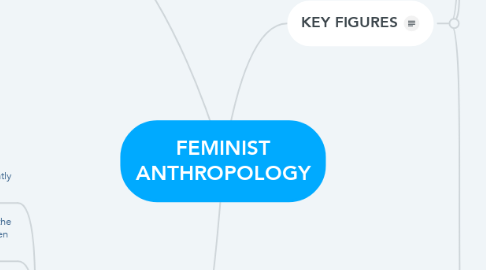
1. MAIN FEATURES
1.1. All social relations are gendered
1.2. Distinctive ethics
1.3. Anti-positivism
1.4. Preference for qualitative methods
1.5. Universal sexual asymmetry
1.6. Anthropology of women versus feminist anthropology
1.7. A female essence
1.8. Gender must be included in our basic term (alongside class, age, etc.)
1.9. Research should be collaborative/dialogical
1.10. Research should empower people
1.11. Science is considered oppressive (the system of science)
1.12. Feminism against Postmodernism and Marxism
1.13. A need for a feminist perspective that isn’t merely absorbed by conventional anthropology
2. CRITICISMS
2.1. Feminism has not been sufficiently experimental
2.2. There is already an assumption that the majority of the social science has been male-biased
2.3. There isn’t much criticism about feminism in anthropology because it was viewed as another approach, hence it was absorbed into anthropology without posing any challenge to it.
2.4. Although there are anthropologists who would speak of feminism in anthropology, it deemed not sufficient enough to be used as a part of anthropologists’ everyday practice.
2.5. Feminism can't be applied to all forms of society because one has to assume first that the said society is gendered, but there are possibilities that it isn't.
2.6. It's female centered views gives it a bias when it comes to research rather than actually obtaining truth value.
2.7. It's a political agenda and an advocacy in nature, much like Marxism.
2.8. Feminism has yet to achieve the strong basis of research and discourse Marxism has, but it should lead to a non-sexist and form of research and discussion.
3. KEY FIGURES
3.1. MARJORIE SHOSTAK
3.1.1. Looked into what it meant to be female amongst the !Kung (gatherers and hunters living in Botswana)
3.1.2. Published “Nisa: The Life and Words of a !Kung Woman”
3.1.2.1. Became a successful experiment in feminist anthropology
3.1.2.2. Gave !Kung women a voice and humanized them
3.1.2.3. Research contained honesty and candid reflections
3.1.2.4. Even though the research was successful, Shostak had doubts about the information given to her by Nisa
3.1.2.5. Main theme of the book: Nisa’s obsession with sex
3.1.2.6. Presented the ethnographic history of members of another culture, and basically allowed them to tell their stories of their beliefs and cultures.
3.1.3. Was able to elevate the ethnographic enterprise of anthropology to a higher level
3.2. MARILYN STRATHERN
3.2.1. Anthropology is too tolerant when it comes to feminist studies
3.2.2. Published “An Awkward Relationship: The Case of Feminism and Anthropology”
3.2.2.1. Focused on the clash between interdisciplinary feminism and autonomous disciplines
3.2.3. There is a gap between the researcher and patriarchy or the male in feminist anthropology
3.2.3.1. Feminist anthropologists sustain this gap
3.2.3.2. Necessary for the existence of the feminist self
3.2.3.3. Creates a collaboration
3.2.4. Wants to reinforce a wall that separates mainstream anthropology from feminist anthropology
3.2.5. Dwelled on difference, power, and hierarchy
3.2.6. Focused on feminist anthropology because although it is acknowledged as a discipline, it is not used in practice.
3.3. ELVI WHITTAKER
3.3.1. Supplied a clear picture of the problems and aims of feminist scholarship.
3.3.2. Feminism and postmodernism are often seen as women's and men's problems, both primarily concerned with inequality (the portrayal of women by men, and historically by Western social scientists).
3.3.3. The relationship between women and men is equivalent as there is between the colonized and the colonized
3.3.4. Science is a socially traditional, gendered practice that seeks to recreate the conditions that perpetuate the patriarchy.
3.3.5. Grand theory and all-encompassing models merely depersonalize and distort.
3.3.6. Feminism promotes multiple, contested truths and ethnographic texts that are fragmented and incomplete rather than neat and polished finished products (the artifacts of science).
3.3.7. Whittaker’s forceful and polemical vision of feminist methodology, consider the following as the “research” scene.
3.3.7.1. The goals of common interest and understanding are built in collaboration with others.
3.3.7.2. The results are not available to authors and authorities Interviewing and other positive techniques are disappearing.
3.3.8. Feminism is a way for women to articulate their misgivings towards men
3.3.9. It's goal is to undermine the oppression that women are induced in
3.3.10. There is no separation between the researched and the researcher, there is no objectivity only subjectivity.

